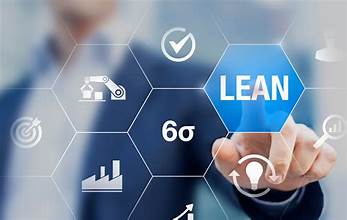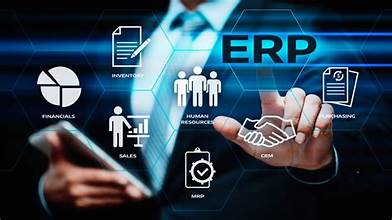Our Services
Comprehensive IT solutions for your enterprise needs, backed by 18 years of proven experience.
Odoo ERP Solutions
Implementation, customization, and support for Odoo ERP to enhance your business operations effectively.
IT Infrastructure Management
Transform your enterprise with our next-generation technology and data-driven IT infrastructure management services.
Comprehensive ERP solutions
Odoo is an open-source Enterprise Resource Planning (ERP) software that provides a comprehensive suite of business applications designed to manage and streamline various business processes. It includes modules for accounting, inventory, sales, marketing, human resources, manufacturing, project management, and more.

We offer two ERP options odoo and ERP-next because every business has different needs. Some companies want a simple system, while others need a more advanced and customizable platform. By giving two choices, we help every business find the right fit. We also sell ERP along with our consulting and automation services because software alone cannot solve all problems. Companies need better processes, clear workflows, and real-time visibility. ERP provides one system for all departments, reduces manual work, improves accuracy, and increases control. It helps businesses scale, save time, reduce costs, and deliver better customer experiences. ERP creates smooth, efficient operations.

Clarice Turner
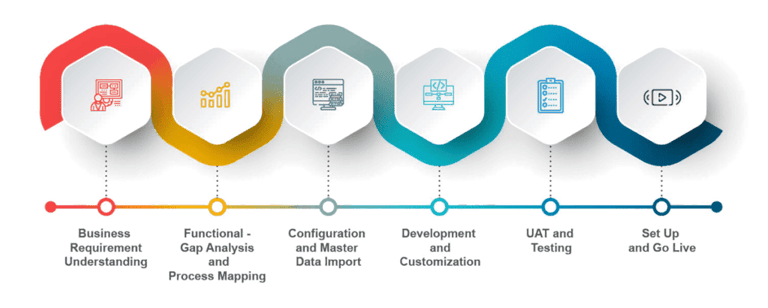

★★★★★
Implementation methodology ERP systems
Requirement Gathering: Identify and document business processes, needs, and expectations.
Gap Analysis: Compare current business processes with ERP capabilities to identify gaps that need to be addressed.
System Blueprint Design: Create a blueprint that outlines how the ERP system will be configured to meet business requirements.
Data Migration Planning: Plan for the migration of data from legacy systems to the new ERP system.
System Configuration: Configure the ERP system according to the blueprint and business requirements.
Customization (if needed): Develop custom features, workflows, or reports to bridge gaps that cannot be addressed by standard configurations.
Integration: Integrate the ERP system with other applications or third-party systems (e.g., CRM, HRMS, eCommerce).
integration Testing: Verify that different modules and integrations work seamlessly together.
User Acceptance Testing (UAT): Involve end-users in testing the system’s functionality to ensure it meets business requirements and is user-friendly.
Change Management: Prepare the organization for changes, address resistance, and ensure smooth adoption of the ERP system through effective communication and support.
Go-Live Preparation: Finalize all configurations, confirm system readiness, and resolve any remaining issues.
Go-Live: Switch over to the new ERP system and monitor performance closely.
Post-Go-Live Support: You receive up to 4 months of free support, including quick issue resolution, user assistance, and system fine-tuning to ensure stable and efficient operations.
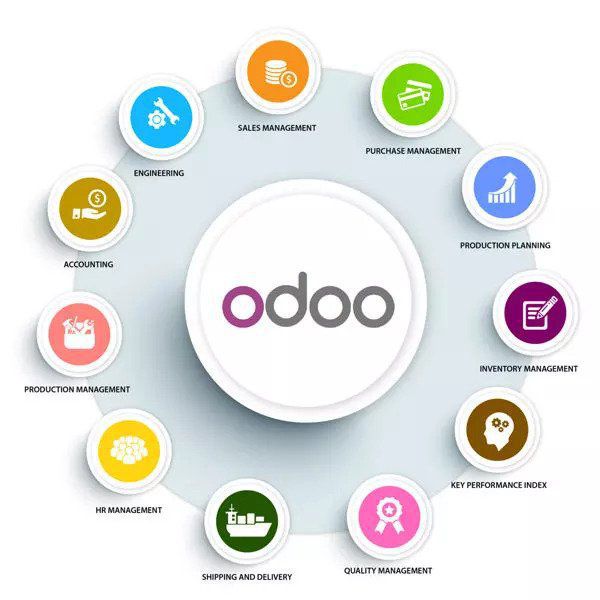

Advantages of this ERP integration
CRM Management: Comprehensive lead management, linked to sales and marketing, enhances customer engagement and conversion rates through integrated workflows.
Sales Management: Real-time access to customer data, stock availability, and automated quotations enable seamless order management and improved customer service.
Production Planning: Demand-driven production planning ensures efficient resource allocation, automated scheduling, and reduced overproduction.
Purchase Management: Automated replenishment linked to inventory and production helps maintain optimal stock levels while providing cost control and supplier management.
KPI Management: Holistic performance tracking through integrated dashboards provides real-time insights across sales, HR, and finance for informed decision-making.
Quality Management: Integrated quality checks and non-conformance management enhance product compliance and streamline supplier quality tracking.
Shipment and Delivery: Logistics optimization automates delivery orders, reduces shipping errors, and provides real-time tracking for faster order fulfillment.
Human Resources (HR): Centralized employee data linked with payroll, attendance, and recruitment improves HR efficiency and talent management.
Logistics: Integrated inventory management with real-time stock tracking and automated warehouse operations streamlines logistics and distribution.
Engineering Management: Centralized design and product data management streamline engineering processes and improve collaboration with production and quality teams.
All under one umbrella
Comprehensive Lean Manufacturing solutions
Lean manufacturing is a production philosophy focused on minimizing waste and maximizing efficiency to deliver higher value to customers. It originated from the Toyota Production System and emphasizes continuous improvement, streamlined processes, and resource optimization.

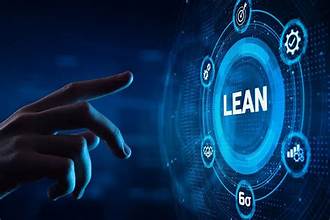

Why Lean manufacturing Implimentataion services
Enhanced Efficiency: Streamlined workflows lead to faster production cycles and reduced lead times.
Cost Reduction: Minimized waste and optimized resource use lower overall production costs.
Improved Quality: Lean principles focus on quality control and error prevention, leading to higher product quality.
Better Resource Utilization: Effective allocation of resources, including labor, materials, and equipment, increases productivity.
Higher Flexibility: Adaptable production processes enable companies to respond more quickly to changes in customer demand or market conditions.
Employee Engagement: Lean encourages a culture of continuous improvement, motivating employees to contribute to process enhancements.
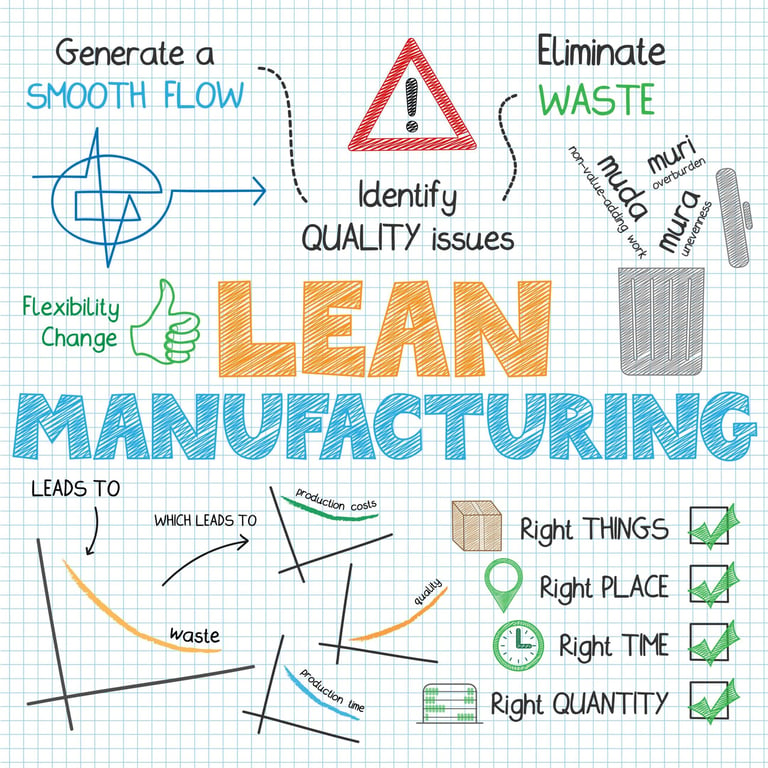

Lean manufacturing in a nut shell
5 Fundamental Principles in Lean
Defining Value: The first step in Lean Manufacturing is understanding and defining value from the customer’s perspective. This means identifying what the customer values in the product or service so that efforts can be directed toward meeting those needs.
Mapping the Value Chain: After defining value, the next step is to map the value stream, identifying all activities from raw material processing to the final product reaching the customer. The goal is determining which steps add value and which ones do not, laying the groundwork for waste elimination.
Creating Flow: With the value stream mapped, the objective is to make products flow continuously without interruptions. This involves improving processes, reducing production batches, and eliminating waiting times, ensuring a more agile and efficient production.
Establishing a Pull System: Instead of producing based on forecasts, Lean Manufacturing promotes demand-driven production, producing only what is needed, when requested, and in the required quantity. This reduces excess inventory and increases the ability to respond to market needs.
Pursuing Perfection: The final principle is continuously searching for perfection, where continuous improvement integrates the company’s culture. This involves constantly optimizing processes, encouraging innovation, and involving employees in problem-solving.
Solutions
Transforming enterprises with next-gen IT services.
Consulting
Support
+971557708994
© 2024. All rights reserved.



